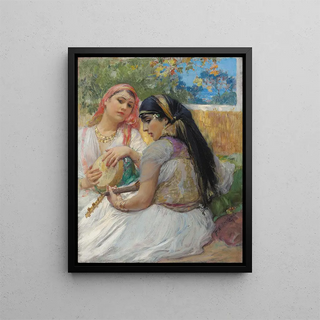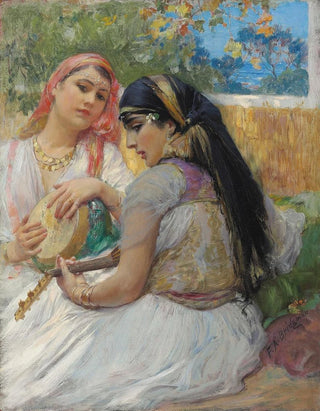Art print | Two Young Algerians - Frederick Arthur Bridgman


View from behind

Frame (optional)
In the vast panorama of art history, certain works manage to capture the essence of an era while transcending cultural boundaries. "Deux jeunes Algériens" by Frederick Arthur Bridgman is one of those creations that evoke both the beauty of everyday life and the richness of a culture. This painting, both delicate and powerful, transports the viewer to a world where light and colors intertwine to tell a story. Bridgman, a 19th-century American artist, skillfully captured with remarkable precision the features and traditions of his subjects, offering a fascinating glimpse into life in Algeria at that time.
Style and uniqueness of the work
Bridgman's style is distinguished by mastery of light play and meticulous attention to detail. In "Deux jeunes Algériens," the figures stand with natural grace, their traditional clothing vibrant under the nuances of sunlight. The artist created an intimate atmosphere where the viewer can almost hear the whisper of conversations and feel the warmth of the Algerian climate. The faces of the young men are imbued with psychological depth that invites contemplation. Every brushstroke seems charged with emotion, making the work all the more immersive. Furthermore, the background, though less detailed, evokes a typical Algerian landscape, enhancing the authenticity of the scene while allowing the figures to stand out brightly.
The artist and his influence
Frederick Arthur Bridgman, born in 1847, was deeply influenced by his travels in North Africa, particularly in Algeria. These experiences enriched his work, enabling him to develop a personal style that blends realism and romanticism. Bridgman was one of the first Western artists to depict Arab culture with such sensitivity, challenging the stereotypes of his time. His innovative approach paved the way for other artists, contributing to a better understanding and appreciation of Eastern cultures in Europe and America. By incorporating elements of Algerian daily life into his paintings, he not only celebrated the beauty of these cultures but also encouraged intercultural dialogue that remains relevant.

Matte finish

View from behind

Frame (optional)
In the vast panorama of art history, certain works manage to capture the essence of an era while transcending cultural boundaries. "Deux jeunes Algériens" by Frederick Arthur Bridgman is one of those creations that evoke both the beauty of everyday life and the richness of a culture. This painting, both delicate and powerful, transports the viewer to a world where light and colors intertwine to tell a story. Bridgman, a 19th-century American artist, skillfully captured with remarkable precision the features and traditions of his subjects, offering a fascinating glimpse into life in Algeria at that time.
Style and uniqueness of the work
Bridgman's style is distinguished by mastery of light play and meticulous attention to detail. In "Deux jeunes Algériens," the figures stand with natural grace, their traditional clothing vibrant under the nuances of sunlight. The artist created an intimate atmosphere where the viewer can almost hear the whisper of conversations and feel the warmth of the Algerian climate. The faces of the young men are imbued with psychological depth that invites contemplation. Every brushstroke seems charged with emotion, making the work all the more immersive. Furthermore, the background, though less detailed, evokes a typical Algerian landscape, enhancing the authenticity of the scene while allowing the figures to stand out brightly.
The artist and his influence
Frederick Arthur Bridgman, born in 1847, was deeply influenced by his travels in North Africa, particularly in Algeria. These experiences enriched his work, enabling him to develop a personal style that blends realism and romanticism. Bridgman was one of the first Western artists to depict Arab culture with such sensitivity, challenging the stereotypes of his time. His innovative approach paved the way for other artists, contributing to a better understanding and appreciation of Eastern cultures in Europe and America. By incorporating elements of Algerian daily life into his paintings, he not only celebrated the beauty of these cultures but also encouraged intercultural dialogue that remains relevant.






